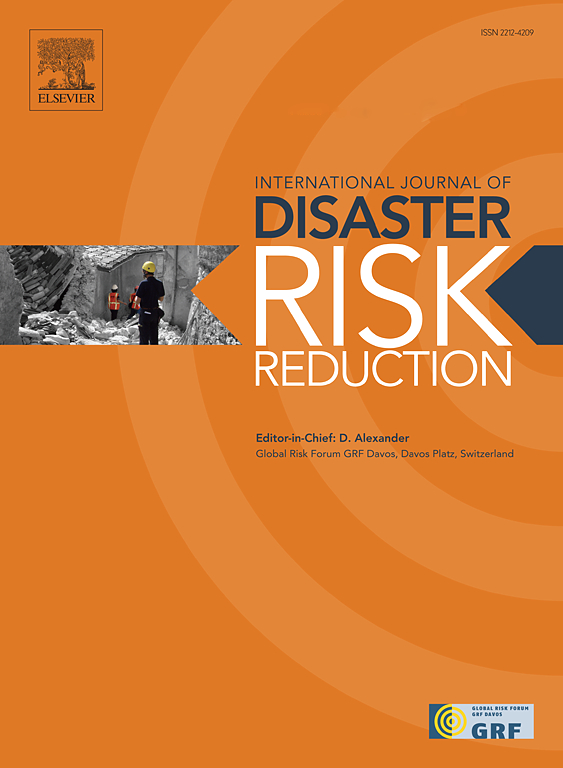地区灾害风险决定保险支出吗?来自印度有组织制造工厂的证据
IF 4.2
1区 地球科学
Q1 GEOSCIENCES, MULTIDISCIPLINARY
International journal of disaster risk reduction
Pub Date : 2024-11-01
DOI:10.1016/j.ijdrr.2024.104964
引用次数: 0
摘要
保险是企业重要的风险管理工具。本文研究了决定印度有组织制造业工厂保险支出的因素,重点关注地区灾害风险的作用。我们利用《2018-19 年度工业调查》中的单位层面数据,收集有关保险支出和其他工厂层面因素的信息。我们将这些数据与印度各邦的空间灾害风险指数相结合,后者来自印度政府内政部和联合国开发计划署(UNDP)的《印度的灾害风险和抗灾能力》报告。邦一级的灾害风险指数捕捉了影响工厂保险支出的地区风险环境,即使在考虑了工厂的特定因素之后也是如此。我们在多元线性回归框架下使用普通最小二乘法检验了有关工厂级保险支出决定因素的各种假设。鉴于保险支出的决定反映了一个角解问题,即相当一部分工厂的支出为零,而其他工厂的支出则完全为正数,我们采用了 Tobit 和 Cragg 的障碍模型来确保稳健性。我们的研究结果表明,基于地理位置的空间灾害风险指数与工厂的保险支出之间存在正相关,且在统计上具有显著性。位于灾害风险较高州的工厂的保险支出明显更高。在其他工厂层面的因素中,我们的研究结果表明,总附加值、补贴、进口投入品价值、出口份额、组织类型、年龄、厂房和机器价值以及折旧等因素对保险支出有显著影响。本文章由计算机程序翻译,如有差异,请以英文原文为准。
Do regional disaster risks determine insurance spending? Evidence from organised manufacturing factories in India
Insurance is a crucial risk management tool for firms. This paper examines the factors determining insurance expenditure among organised manufacturing factories in India, focusing on the role of regional disaster risks. We gather information on insurance expenditure and other factory-level factors by utilizing unit-level data from the Annual Survey of Industries for 2018–19. We integrate this data with the spatial disaster risks index across Indian states, obtained from the Disaster Risks and Resilience in India report by the Ministry of Home Affairs, Government of India, and the United Nations Development Programme (UNDP). The state-level disaster risk index captures the regional risk environment that influences insurance expenditure at the factory level, even after accounting for factory-specific factors. We test various hypotheses on the determinants of factory-level insurance expenditure using the ordinary least squares method in a multiple linear regression framework. Given that the decision to spend on insurance reflects a corner solution problem, with a substantial share of factories reporting zero expenditure while others incur strictly positive amounts, we employ Tobit and Cragg's hurdle models to ensure robustness. Our results indicate a positive and statistically significant association between the location-based spatial disaster risks index and factory-level insurance expenditure. Factories located in a state with higher disaster risks spend significantly more on insurance expenditure. Among other factory-level factors, our findings indicate that factors such as gross value added, subsidies, the value of imported inputs, export share, type of organisation, age, the value of plant and machinery, and depreciation significantly affect insurance expenditure.
求助全文
通过发布文献求助,成功后即可免费获取论文全文。
去求助
来源期刊

International journal of disaster risk reduction
GEOSCIENCES, MULTIDISCIPLINARYMETEOROLOGY-METEOROLOGY & ATMOSPHERIC SCIENCES
CiteScore
8.70
自引率
18.00%
发文量
688
审稿时长
79 days
期刊介绍:
The International Journal of Disaster Risk Reduction (IJDRR) is the journal for researchers, policymakers and practitioners across diverse disciplines: earth sciences and their implications; environmental sciences; engineering; urban studies; geography; and the social sciences. IJDRR publishes fundamental and applied research, critical reviews, policy papers and case studies with a particular focus on multi-disciplinary research that aims to reduce the impact of natural, technological, social and intentional disasters. IJDRR stimulates exchange of ideas and knowledge transfer on disaster research, mitigation, adaptation, prevention and risk reduction at all geographical scales: local, national and international.
Key topics:-
-multifaceted disaster and cascading disasters
-the development of disaster risk reduction strategies and techniques
-discussion and development of effective warning and educational systems for risk management at all levels
-disasters associated with climate change
-vulnerability analysis and vulnerability trends
-emerging risks
-resilience against disasters.
The journal particularly encourages papers that approach risk from a multi-disciplinary perspective.
 求助内容:
求助内容: 应助结果提醒方式:
应助结果提醒方式:


